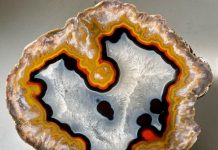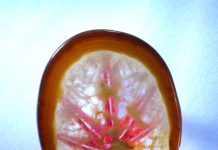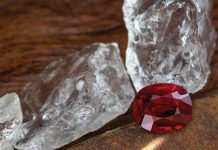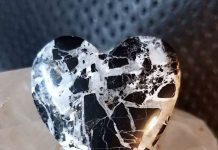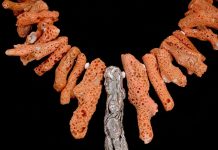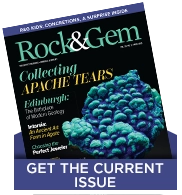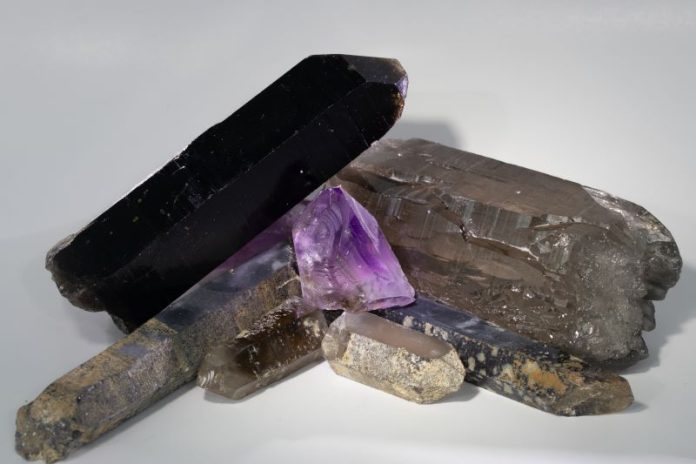
Hallelujah Junction Mine is a place where quartz is king featuring abundant pockets of smokey quartz, amethyst and citrine, which are often found as large scepters. This is a sought-after opportunity.
Situated on Petersen Mountain, along the border of Nevada and California, please note there are multiple mining private claims in this area. Respecting these claims is a professional courtesy and removing materials from a staked claim is a federal offense. With that said, there are also paid dig opportunities allowing professionals and avid enthusiasts to look for their own specimens.
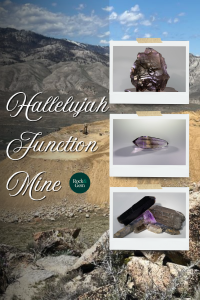
Crystal Scepters
Among the realm of myth and legend, crystal scepters are symbols of power and royalty, and in ancient stories, they were used in the fabled continents of Atlantis and Lemuria as a symbol of authority.
“There’s nowhere like it on earth,” says Ian Merkel, a professional geologist who has been visiting Hallelujah Junction for 16 years. He notes that the size of the scepters found at Hallelujah Junction is rare to see anywhere else.
“It’s very magical. We get some big ones,” says Ryan Anderson, one of the five partners in the southern section of
the block of mining claims. “It’s a special place just to be.”
Getting its Name
The area to dig was dubbed “Hallelujah Junction” because the closest place to meet at the bottom of the mountain is Hallelujah Junction, California. The bounty of quartz specimens atop Petersen Mountain was initially recognized as early as the 1940s. By the early 1980s, Jon Johnson and Foster Hallman, who passed in 2018, staked official claims in the area. Merkel notes that Hallman staked out to the north and Johnson was on the south end. “Both sides added an additional contiguous claim for dumping onto and exploring.”
Anderson is part of the partnership with Johnson, while Merkel works with the northern aspect of the claims.
“We’re all friends,” says Merkel. “The two sections are quite different.”
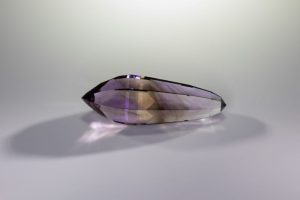
Junction faceted tricolor gemstone
(Mark Oros)
The Reason Behind the Abundance
The geological explanation of why this is such a unique area can fill a book, yet questions remain on the complex systems required to create the large and abundant scepters.
“It happened deep within the earth. There were multiple outgassing/depositional events,” says Merkel.
At its base, quartz is crystallized silicon dioxide. The extent of its growth, as well as its shape and color, depend on multiple factors. Merkel points out that these crystals were deposited from silica-rich fluids. Both are dependent upon magmatic activity heating the rock or the water, followed by cooling to the crystallized form. The area around Hallelujah Junction is primarily made up of granodiorite, an intrusive igneous rock, indicative of an example of slow-cooling crystallization. Different types of quartz are formed when other elements or impurities become part of the process. For instance, when there is iron within the quartz crystals, and it is exposed to radiation, the result is purple amethyst.
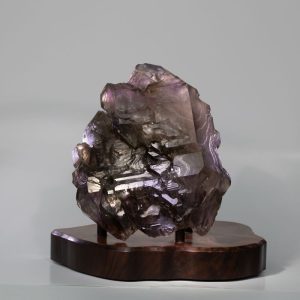
Smoky quartz is generally created with just the presence of aluminum and then radiation that affects the pure white or colorless quartz.
Citrine’s exact formation conditions are still being investigated. In the Hallelujah Junction area, other minerals, such as pyrite, mica and chlorite, add to the different appearance of some of the crystal groups and scepters.
A Day in the Desert
As with all mining, it’s never easy. The first challenge is reaching the site. It is 35 miles from Reno, Nevada, along California State Route 395 then east to the access road — Greasy Hill Road. While the surrounding terrain looks firm, this steep and windy route is practically impassable when wet. Even on dry days, vehicles have been known to stall and roll, making a higher wheelbase 4WD vehicle highly recommended.
The typical desert landscape is dominated by sagebrush and bitterbrush. The top of Petersen Mountain reaches 7857 feet offering breathtaking views overlooking an enormous valley with creek bottoms and lakes that can be seen in the distance.
One thing the claim sites do not have is many trees, and with the exposed nature of the terrain, wind is an issue. At the height of the summer, heat is a critical concern, and thunderstorms regularly send people scrambling for cover.
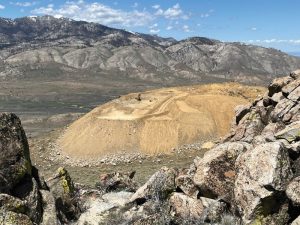
Why Dig Here?
The reason people make the effort to visit is for the exceptional digging experience. For Anderson, who is a trained musician, his interest began in his early 20s. He says, his friend’s teacher told him about Petersen Mountain, so he and his friend went to check it out. “We found (dump) piles and found some things,” he shares. “It ignited a passion I didn’t know existed.” From then on, he spent every spare moment in the dirt.
When it comes to digging at Hallelujah Junction, it’s a matter of reading the terrain. Anderson says there are thousands of crystals and hundreds of pockets. “They’re always subtle signs from the veins,” explains Merkel who says alteration zones project from outside of the veins, which can give a sign that there’s something there.
At this point, it’s a dance between man and machine to efficiently reach the deposit without harming the structure. “I have a tight relationship with those on the machine,” he says. When he is digging, they are constantly keeping an eye on each other, and once Merkel notices anything of interest and gives the signal, it’s less than a second before the machine is stopped. Then the fun begins. “Let’s go see what we’re looking at,” he says. This could be anything from a three-inch pocket of quartz to one that is 15 feet across. “Breccias are like that.”
Unearthing Scepters
A pocket filled with scepters is the dream of everyone who mines on the mountain. Like a cave filled with treasure, there could be scepters jutting out from all directions, along with deposits of quartz crystals. “The unearthing of the scepter is definitely my favorite part. It’s a treasure,” says Anderson.
Excavating everything within a pocket is when the detail work begins. Merkel notes, “You always have to be really careful. When I see people scraping pockets with screwdrivers, I get nervous.” Hand-digging or gently prying with chopsticks is better.
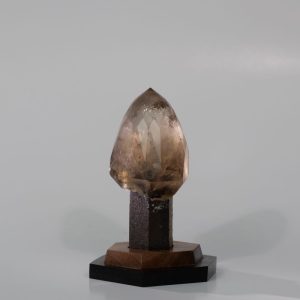
Sharing with Rockhounds
Stepping wholeheartedly into this realm of rock hunting, Anderson shares this passion with other rock enthusiasts. Although Hallelujah Junction claims are privately owned, Anderson and his partners allow paid mining typically from mid-May to mid-June. Popularity has grown through word-of-mouth. “I’ve been all over the country, and (Hallelujah Junction) is one of my favorites, for sure,” says Bryan Major, who produces The Crystal Collector, a popular YouTube channel. He says he knew from his first experience that once the claim crew scraped the walls with the excavator, you had to be ready for a heavy day of digging.
He and his friends found several fist-sized amethysts and amethyst/citrine combinations as they dug into pockets along the wall. “You follow the signs,” he says, noting that sometimes there are individual specimens, while other areas might hold larger pockets. “There were a couple of nice scepters found,” he says. And one of his favorites of the day was an amethyst with a water bubble inside of it. “I don’t know of any place that’s better (for amethyst).”
It’s sometimes hard to believe that a veritable treasure sits atop a mountain with views overlooking the iconic Southwestern landscape. While nothing comes easy, those who have the opportunity to try their hand at Hallelujah Junction gain a great appreciation for these enormous and abundant gemstones and oftentimes bring these specimens home.
This story about Hallelujah Junction Mine appeared in Rock & Gem magazine. Click here to subscribe. Story by Amy Grisak.


